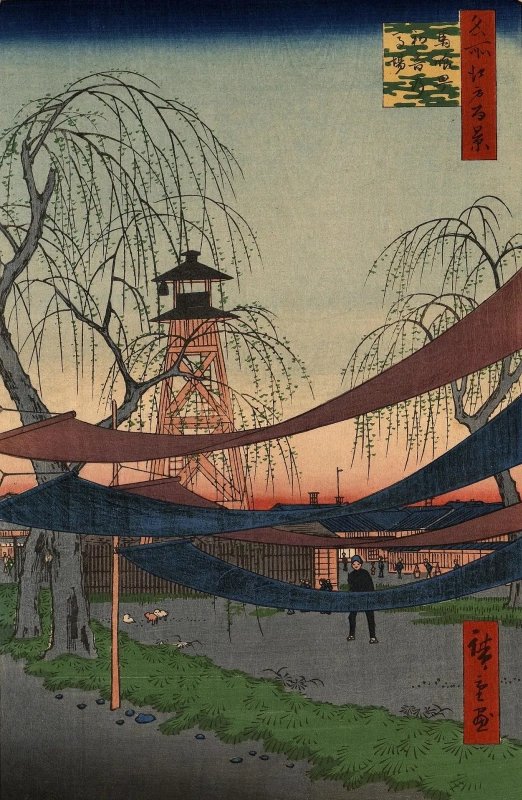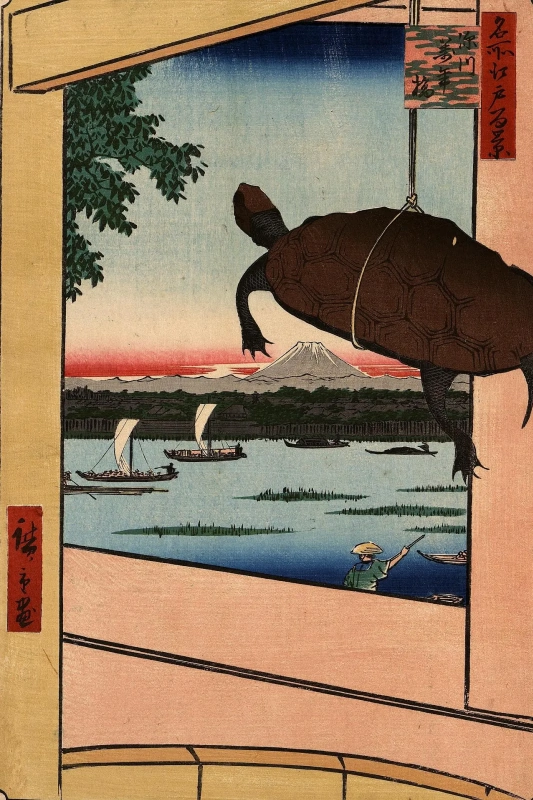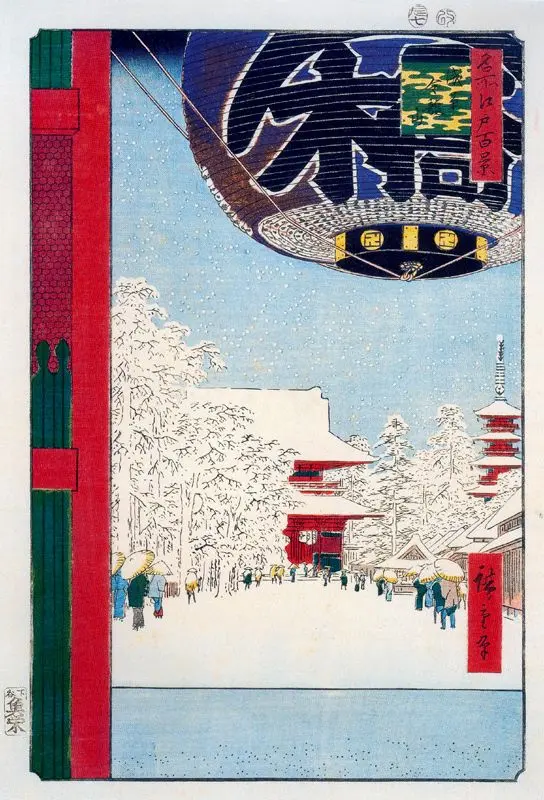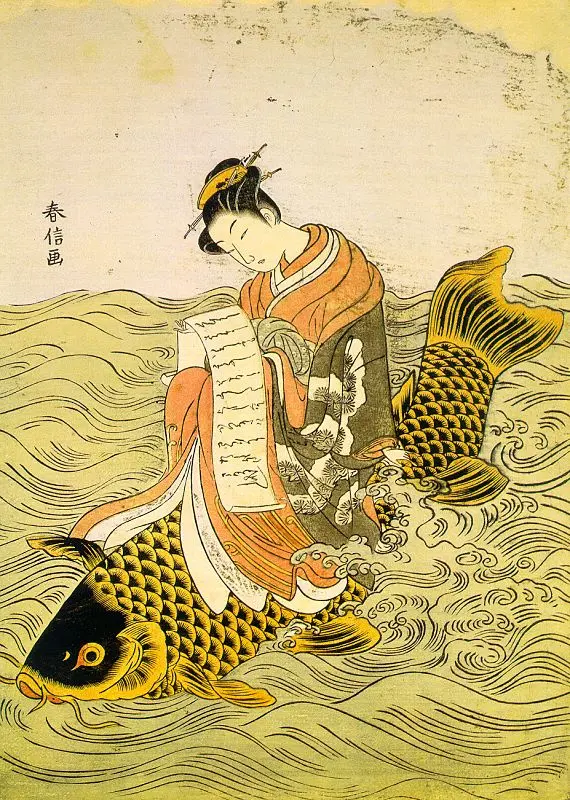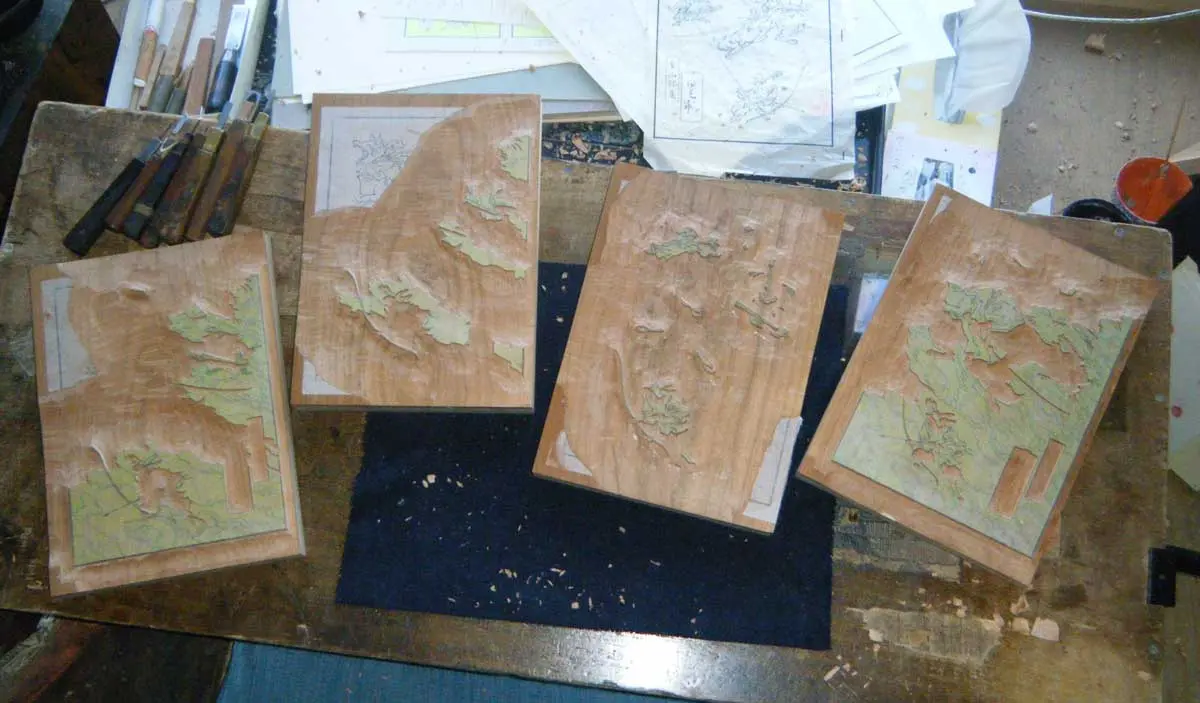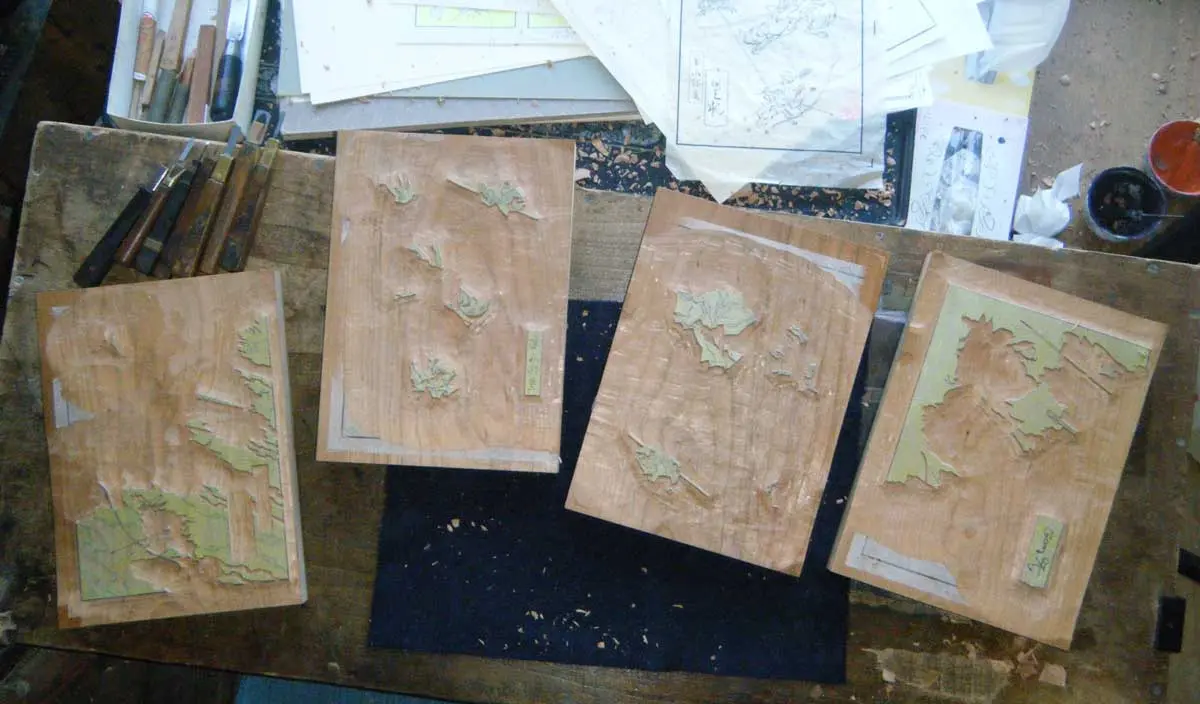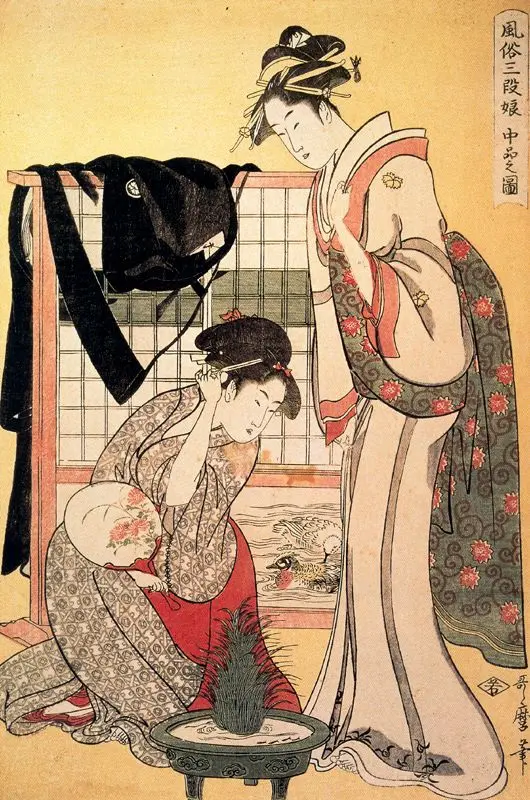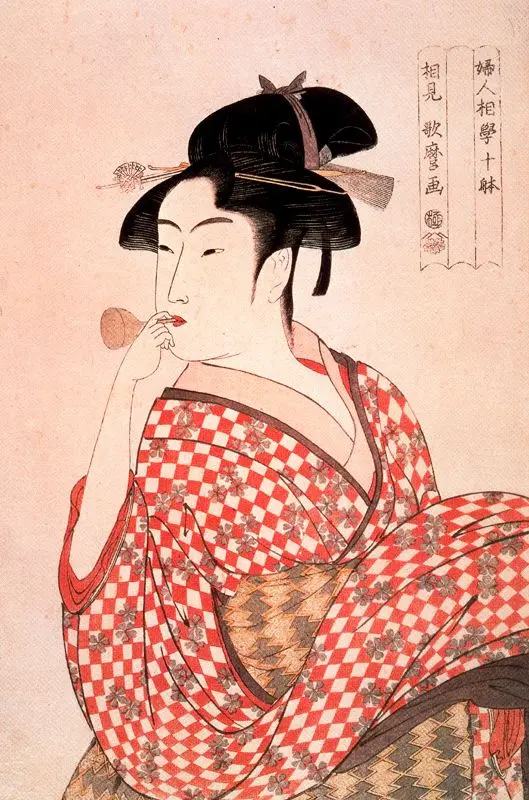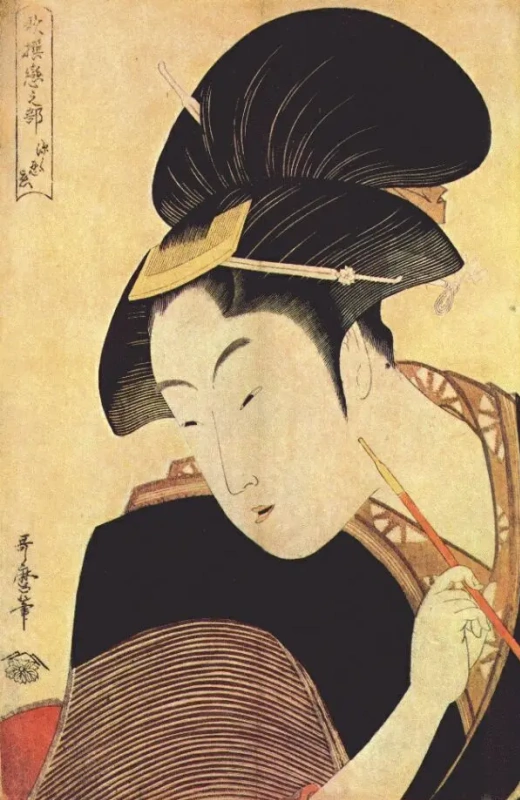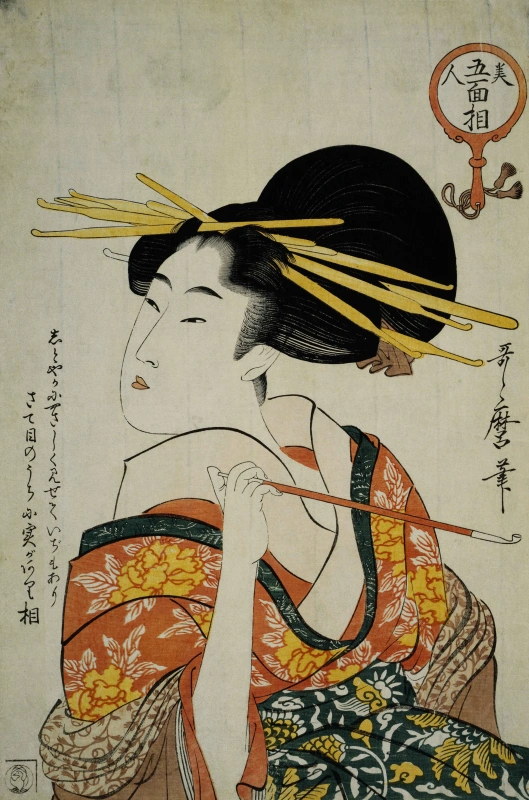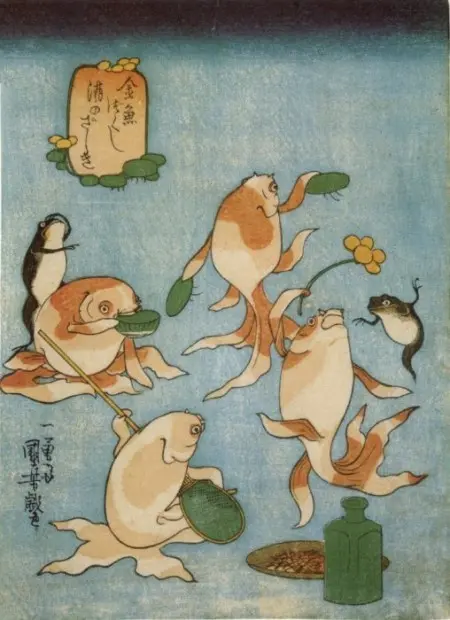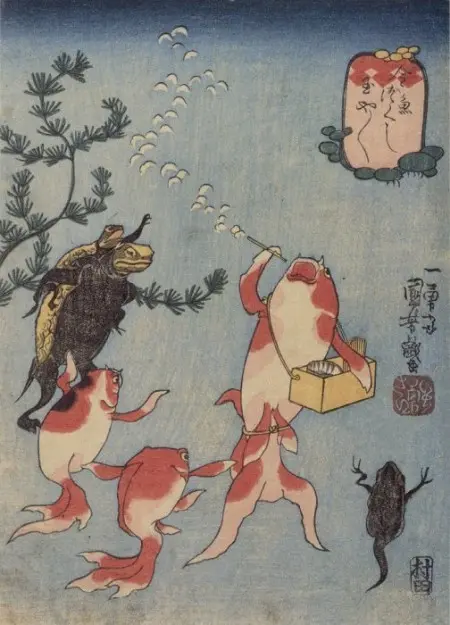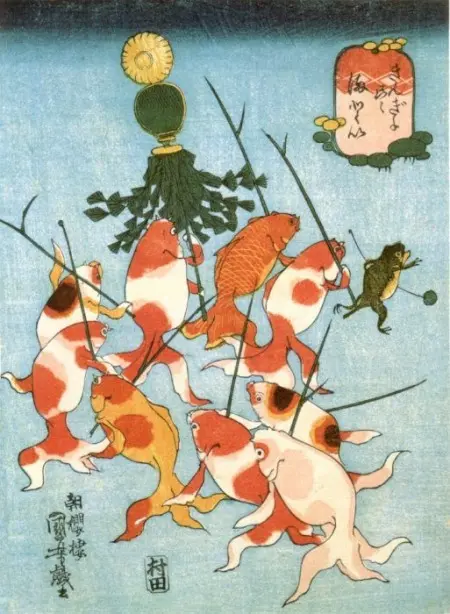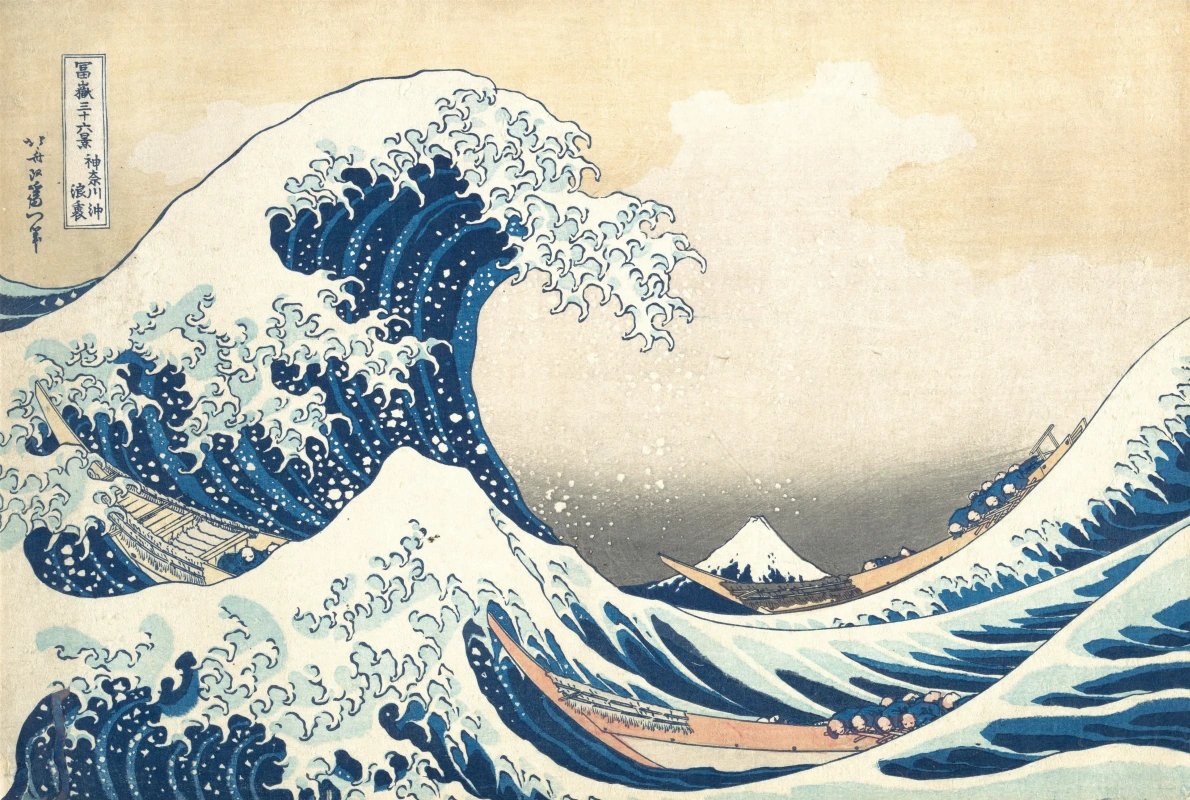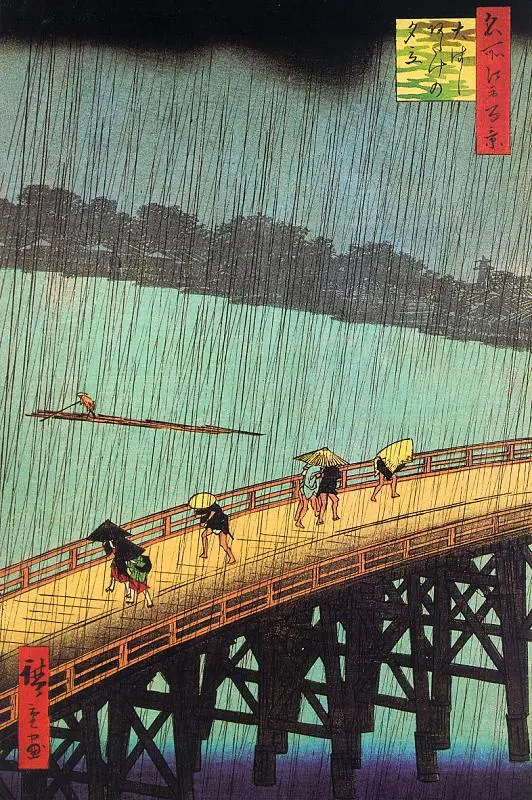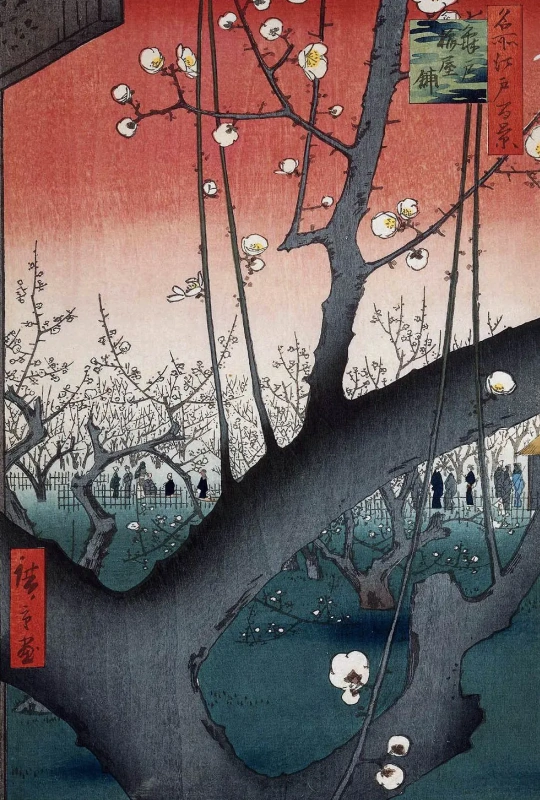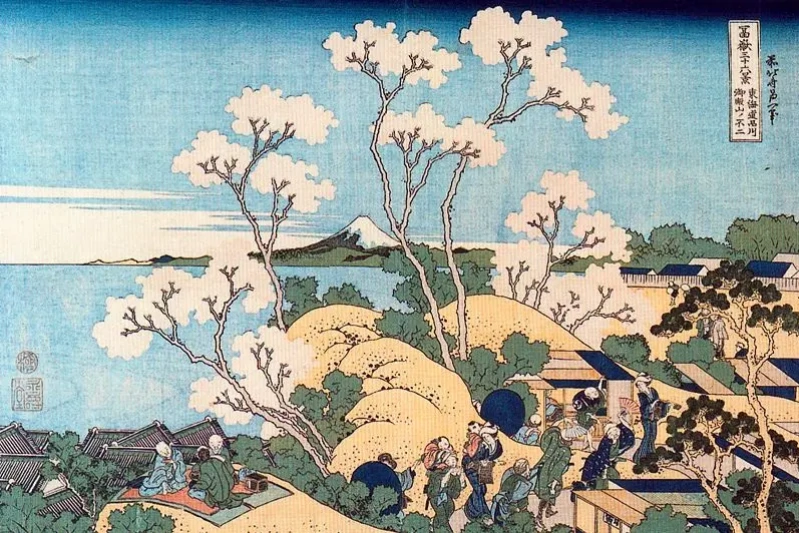Now it seems unbelievable but the Japanese did not regard the woodblock prints, which fascinated the fashionable European artists and inspired the Impressionists to adopt the new ways of expression.

The Ukiyo-e prints were widely spread in the Edo period due to their relatively cheap cost. In fact, initially they fulfilled a purely utilitarian function: to advertise services of courtesans from the pleasure districts, different in popularity and prestige, to portray kabuki actors, and to illustrate all kinds of fiction books.
Woodblock prints by Hiroshige present the quintessence of the Ukiyo-e's philosophy and its favorite subjects: the moon, cherry blossoms, fleeting dusk, geishas and Yoshiwara quarter famous for its merry-making at houses of pleasure.
The beginning of Ukiyo-e
Xylography is a printing method from wooden blocks, loaned from China. Introduced in Japan in the seventh century, it was primarily used in the spiritual sphere: many Buddhist texts and images were reproduced by this method.The mass production in woodblock printing developed much later due to political processes within the country. In 1603, Tokugawa Ieyasu received the title of shogun and founded the Tokugawa shogunate, choosing provincial Edo as its capital (for he had his residence in there). So a village in the swamp became a new capital of Japan. And it is so up until now, although we know this city as Tokyo.
Edo grew rapidly, and the merchant class at the bottom of the Japanese social order benefitted mostly from the city’s quick economic growth. It was the main target audience of the cheap prints which every citizen could afford: the cost of a print was as much as the price of a noodles cup at the time. Whereas traditional Japanese painting still remained expensive and only the chosen ones could afford it.
Exciting pictures
Woodblock prints have become colored not at once. Initially prints were made in a format of black-and-white books. The colors in prints has been introduced gradually. At first, the vermilion — a mixture of sulfur and mercury — was added to the prints by hand. It has given an orange-reddish color (also known as the "Chinese red"). Wild saffron produced a deeper shade of red. Some artists used a black lacquer to color the woodblock prints.Hishikawa Moronobu (1618−1694) is referred as a founder of Japanese woodblock prints in a traditional style. In 1660 he was the first artist who began to publish prints as single-sheet images. Suzuki Harunobu (1725−1770) pioneered producing polychrome woodblock prints called 'brocade pictures' (Nishiki-e) in 1765.
A woman unfolds a love letter
1768, 28.5×19.5 cm
The term "Ukiyo-e" originally expressed the Buddhist idea of the volatile, transitory nature of life. Literary it means "pictures of the floating world." Initially, this word was used to characterize painting as well as prints depicting the daily life of citizens, but as the woodblock prints became more popular and widespread, the ukiyo-e began to associate mainly with them.
Technical questions
In contrast to easel painting, where an artist is the one and only creator, the woodblock printing involves a row of masters. Moreover, an artist has not always taken a leading position in it. He was appointed to make an ink drawing on a transparent paper. However, the end result depended on the skills of a woodcarver or even of several of them.
Modern reconstruction of woodblock printing. Step One: sketches that mark zones of different colors, each is to be cut on a separate wooden block.
Photos of the reconstruction here and below: mokuhankan.com
Printing forms were made of cherry, pear or boxwood blocks cut along the grain of the wood. Sometimes the woodcarvers specialized in certain methods of carving. The most difficult part of the process was carving a face and a hairstyle especially, for a craftsman should cut out each hair separately. Less virtuoso artisans worked on carving clothes, and the apprentices completed the most basic details.
Step Two: wooden blocks, ready to get the paint of the needed color onto their flat surfaces.
Having received the instructions concerning the colors from the artist, the pressman mixed natural pigments to obtain the required hues and made prints on wet paper. Often the woodblocks prints were accompanied by poems. They might be written by an artist himself or, in the absence of the poetic talent, he used the work of another author.
And the finishing touch was made by the seal of a censor, who checked all the woodblocks for compliance with laws prohibiting to depict state or military figures, as well as to illustrate the historical or contemporary events.
And the finishing touch was made by the seal of a censor, who checked all the woodblocks for compliance with laws prohibiting to depict state or military figures, as well as to illustrate the historical or contemporary events.
The main role in woodblock printing Ukiyo-e was often played by the publisher. That was the person who was able to bring fame to an artist. Like modern producers, he could show people the new talents. The level of technical thoroughness of the artworks depended on the craftsmen staff at publishing houses. One of the most influential publishers was Tsutaya Jūzaburō, thanks to him the stars like Kitagawa Utamaro and Katsushika Hokusai started shining on the artistic firmament.
From erotics to ghosts
The number of themes and subjects in the ukiyo-e initially was quite limited. Above all, there were lots of posters advertising theatrical performances of the popular Kabuki actors (such pictures were called yakusha-e) and bijin-ga — "the pictures of beautiful women." The latter were devoted primarily to courtesans and geisha girls from teahouses, advertising their services. Later on, there appeared musha-e ("warrior prints") and surimono — "printed thing," a term used for privately issued or commissioned ukiyo-e. They were often printed on small, nearly square sheets of high-quality paper in limited edition commissioned by wealthy people to commemorate special events, holidays or to announce important public performances or for personal occasions.
High society
XVIII century
A recognized authority in bijin-ga genre is Kitagawa Utamaro. His beauties defined the standard of Japanese women’s beauty, and his style is recognized unmistakably: roughly speaking, he is the father of "the stylish glamour girls."
Another one of the earliest and most popular genres was shunga — erotic prints with somewhat pornographic scenes that had much concerns over the matter in European culture for the level of frivolousness (although prints depicted people dressed up mostly rather than stripped). The Japanese found no trouble in naturalistic details: for them it was just one of many other natural spheres of human existence, the same as eating, although this one was depicted much less.
Illustrations of tales, myths and legends, the worse, the better, were in great demand. The Japanese love the stories about ghosts and monsters, and this is reflected in the woodblock prints. The recognized artists have even created thematic series, such as "100 Ghost Stories" by Katsushika Hokusai. Just look at one sheet from this series dedicated to the most famous Japanese ghost — Onryō - The Ghost of Oiwa (Oiwa-san)!
Illustrations of tales, myths and legends, the worse, the better, were in great demand. The Japanese love the stories about ghosts and monsters, and this is reflected in the woodblock prints. The recognized artists have even created thematic series, such as "100 Ghost Stories" by Katsushika Hokusai. Just look at one sheet from this series dedicated to the most famous Japanese ghost — Onryō - The Ghost of Oiwa (Oiwa-san)!
Above: Oiwa by Utagawa Kuniyoshi, below: selection of funny prints also by him, illustrating the tales about the adventures of Carp Koi fish.
Flora
and Fauna had their place of honor in the Japanese woodblock prints, and a separate genre — kachō-e (ja) — which translates as "flower-and-bird pictures" - was open to more than just images of flowers and birds. As in the European painting of the Renaissance
, in ukiyo-e, the landscape
stood out in a separate genre relatively late. This revolution was made by Katsushika Hokusai, who released a series of "36 Views of Mount Fuji." The album was a runaway success, which has brought the master a lot of followers and imitators.
Ukiyo-e: summary
Ukiyo-e artists:
Utagawa Hiroshige, Hishikawa Moronobu, Suzuki Harunobu, Katsushika Hokusai, Utagawa Kuniyoshi, Kitagawa Utamaro, Kawanabe Kyōsai, Utagawa Kunisada, Tsukioka Yoshitoshi, Keisai Eisen, Toyohara Kunichika, Ogata Gekkō, Hasui Kawase.Most famous ukiyo-e prints:
'The Great Wave off Kanagawa' by Katsushika Hokusai is one of the most replicable images in fine arts that one can meet in the most unexpected places: from logos to street sculptures.'Three Beauties of the Present Day' by Kitagawa Utamaro, a print that preserved for eternity the faces of three most popular girls in Edo at the moment the woodblock print was made — Tomimoto Toyohina, Naniwaya Kita, Takashima Hisa.
And also 'The Plum Garden in Kameido' and 'Sudden Shower over Shin-Ōhashi Bridge and Atake' by Utagawa Hiroshige (Ando) which would seem so familiar to the fans of Vincent van Gogh who painted them in his own manner when he was fond of the Japanese woodblock art printing.
The great wave off Kanagawa
1832, 25.7×37.9 cm
You're a layman, if:
— you consider that the word "uki-e" is misspelled. Literally it means "painting of relief." The Japanese gave this particular name to the ukiyo-e prints in which an effect of depth was produced. Those pieces were so different from the rest of Japanese paintings because the artists used the Western geometrical perspective.You're an expert, if:
— you can define 10 additional sheets from the renowned series "Thirty-six Views of Mount Fuji" by Katsushika Hokusai by checking their contour lines. Unlike the first woodblock prints, their contours are colored in a black, not in a dark blue paint.
Fuji from the mountain Gotenyama river Shinagawa
1802, 47×70 cm
Witten by Natalia Azarenko.
Main illustration: Katsushika Hokusai, South Wind, Clear Sky (Red Fuji).
Main illustration: Katsushika Hokusai, South Wind, Clear Sky (Red Fuji).








